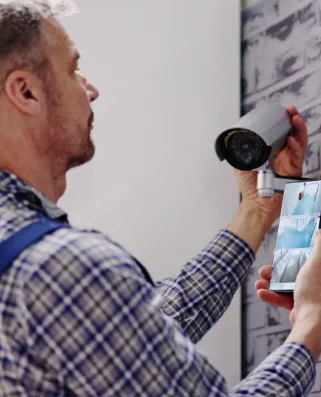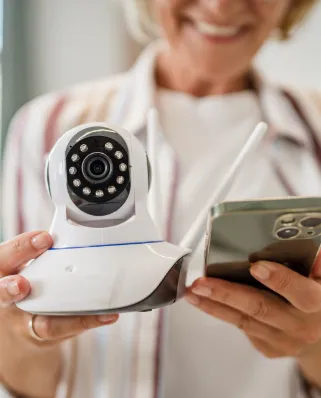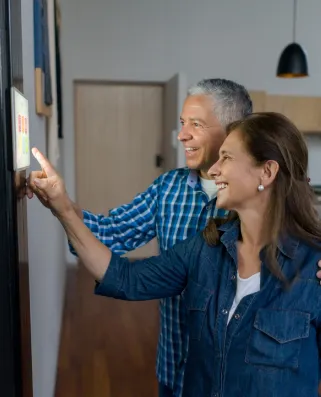Making your space more secure … locks, lights and vigilance, part 2
No home security measures or security systems are 100% foolproof.
But sometimes, it just comes down to making your house harder to break into than the next guy’s. If your house isn’t easy pickings (pardon the pun), the burglar might move on to another house that’s not so much work.
In Part 1 of Making your space more secure … locks, lights and vigilance, we touched on several first-line-of-defense measures you can do to make your home more secure.
An added layer of protection to those tips is a home security system.
According to a study at the University of North Carolina (albeit funded by trade groups of the electronic alarm industry), over 80% of convicted burglars said they would try to determine if a target had an alarm system — with 60% saying they’d back out of the burglary if a security system was in place. (Less than 25% of U.S. houses have a security system in place. Some statistics say that number is lower — only 17%.)
If you’re considering a home security system, but don’t know the first thing about them, an overview might help.
This article isn’t intended to make you a home security system pro, but to give you descriptions and terminology of the different types of systems to help you understand what’s available if you decide to explore the topic further. Or, the techie in your family can probably get you set up with one or more do-it-yourself components in no time.
Home security system purpose and components
Home security systems are integrated systems that combine several electronic components to monitor and alert you about burglaries, home invasions, fires or other threats.
The typical components of a home security system you can tailor to your needs are:
- Keypad that allows you to arm and disarm the system
- Entry sensors that detect when a door, window or other entry point is used
- Flood lights — coupled with motion sensors — to light up exterior areas
- Glass-break sensors that can detect movement inside your home and alert you or a monitoring company
- Panic button that allows you to press a single button to alert the monitoring company of a threat
- Security cameras providing real-time and recorded video and still images
- Siren to alert you and neighbors of a threat and to scare off intruders
- Smoke and carbon monoxide detectors to alert you and the monitoring company of a fire or toxic gas leaks
- Video doorbells that allow you to see and talk to people at your door
- Base station to sync the various components
- Window stickers and yard signs to warn potential intruders that a security system is monitoring your home
Types of home security systems
Professional systems come with 24/7 professional monitoring. They typically don’t connect directly to your local fire, police and emergency services. The call center reps can notify local first responders in an emergency.
Some home security systems no longer require a trained technician to install them. With Wi-Fi-based systems now available, you can choose a do-it-yourself (DIY) option, which can be more practical and affordable.
Any device that connects to the internet can be hacked. Use the same caution with a Wi-Fi home security system you use with all your internet-connected electronic devices:
- Set up two-factor authentication
- Create a strong, secure password
- Talk to the company you choose about other system-protection measures you can take.
There are several types of home security systems to choose from to fit various needs and budgets:
(The brand names mentioned here are not endorsements. You’d want to do your own research on these and other companies. According to Consumer Reports, there are more than 170 brands to choose from.)
Professional systems
- Systems that are installed professionally and those monitored by a response team at a call center.
- The response team is trained to respond and notify local authorities as well as family members or neighbors in the event of an alert.
- Examples: ADT, Vivint, Brinks
DIY (do-it-yourself) systems
- DIY home security systems allow you to put the system together and monitor it yourself, typically through a mobile app.
- DIY systems may also offer professional monitoring for an extra fee.
- Examples: Ring, SimpliSafe, Wyze
Local-only security systems
- Not connected to the internet.
- Don’t provide monitoring and notifications.
- You only know there’s a threat if you’re near the alarm when it goes off.
- No remote; system must be reset manually, typically from a wall keypad or base station.
Smart security systems
- Connected to the internet, which allows you to monitor your home live from a mobile app or other internet-connected device.
- System alerts you when it’s triggered.
- You can control the system remotely from the app.
Hard-wired systems
- Hard-wired into your home’s electrical system.
- May include both professional and DIY home security systems.
- Can use either landlines or cellular systems to alert you or monitoring services.
- Continues working even if your internet connection goes down.
Wireless systems
- Not connected to your home’s electrical system.
- Requires batteries, Wi-Fi or cellular connections to power and connect the various components.
- Tends to be easier to install if you want a DIY home security system.
- Need to monitor and replace batteries as needed.
There’s no one-size-fits-all approach to home security.
Assess your needs and budget before making any decisions on security enhancements you’d like to make to your home.
Whichever ones you select will be the right ones to help give you peace of mind.
Home security and medical alert systems have different purposes. A home security system protects your property against intruders or other threats. A medical alert system protects you in the event of medical emergencies, accidents and injuries.
If shopping for either kind of system, ask if it can be incorporated into an all-in-one medical alert/home security system. Even if you don’t want both now, it gives you the option of upgrading in the future if you change your mind.
In a word, possibly. But fake signs, stickers and decals come with some risks:
- Fake signs can be easy to spot. A quick online search can tell a burglar if a sign/company name is real.
- Even though many legit companies sell their security signs online, unauthorized use of them could be considered copyright infringement.
- With fake signs — and a false sense of security — you might let your guard down.
If you’re not interested in a complete home security system, consider installing security cameras. Wired cameras require more set-up and effort but offer greater reliability. Wireless security cameras are less expensive and set up quickly but network failure and on-site tampering can occur.
One crime-media relations expert says he uses a combination of real and fake cameras, and uses stickers letting would-be burglars know video cameras are in use.






